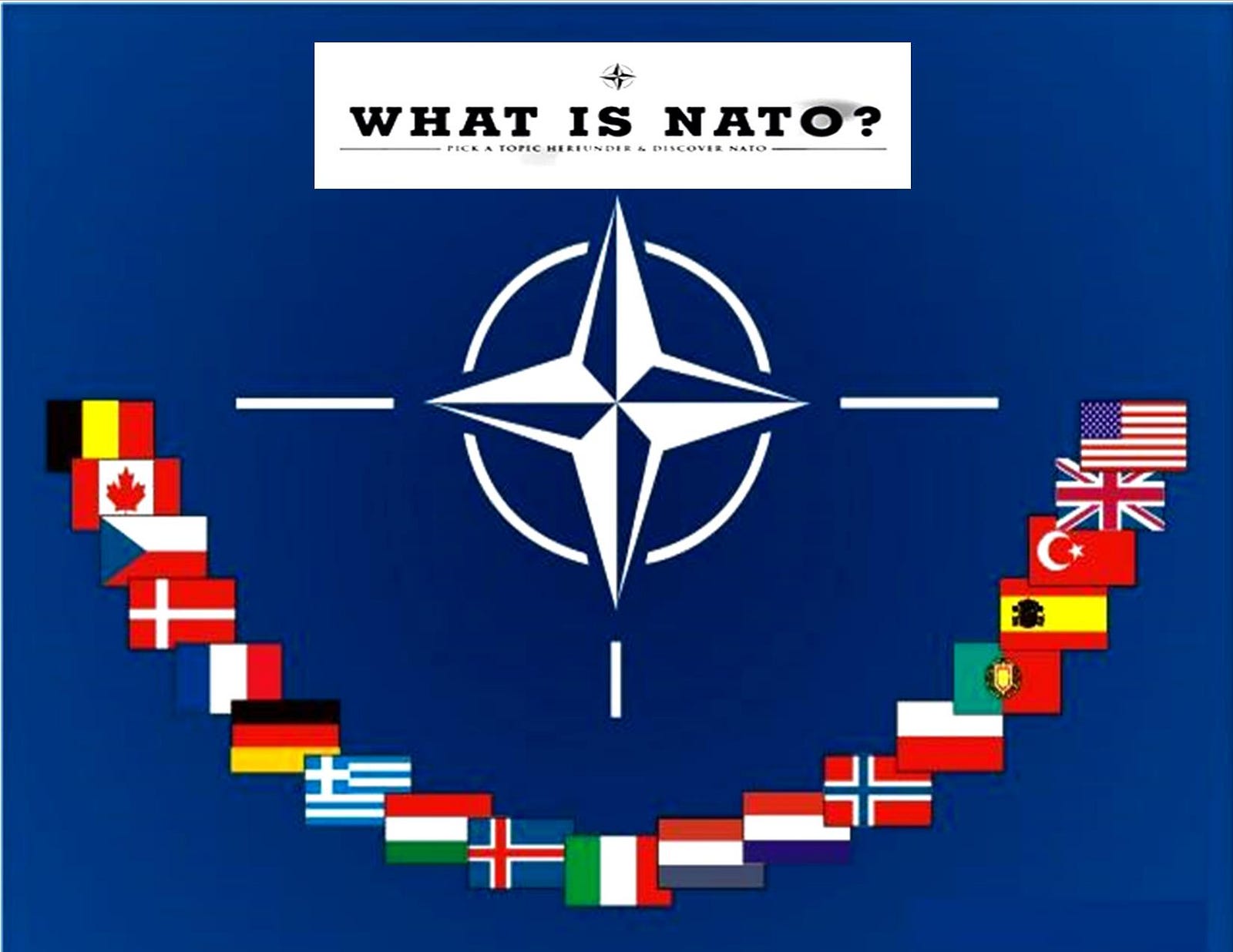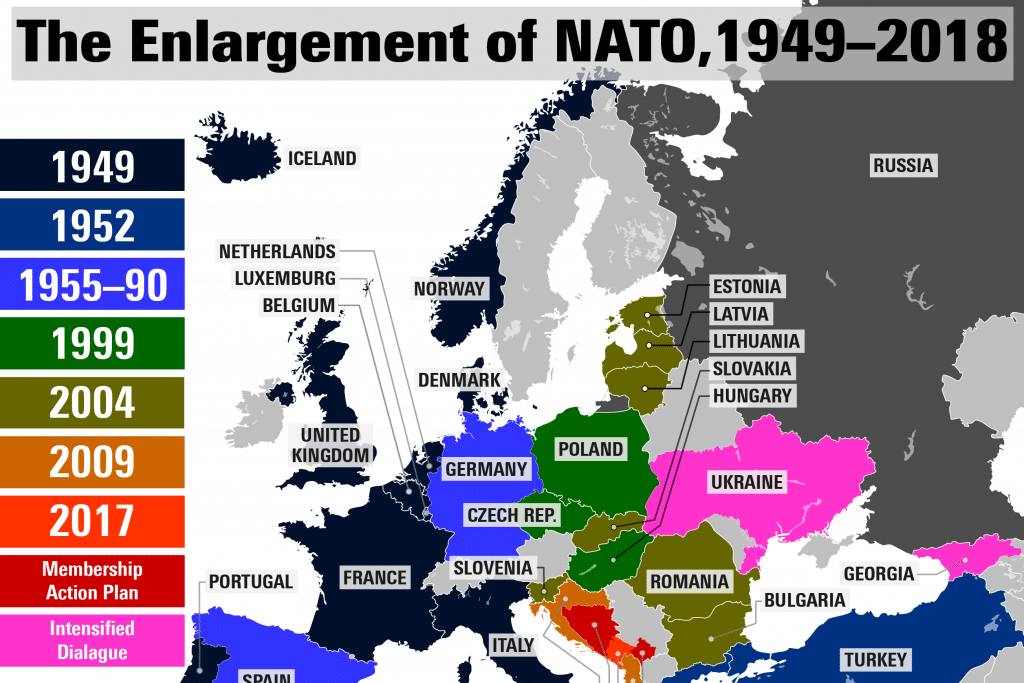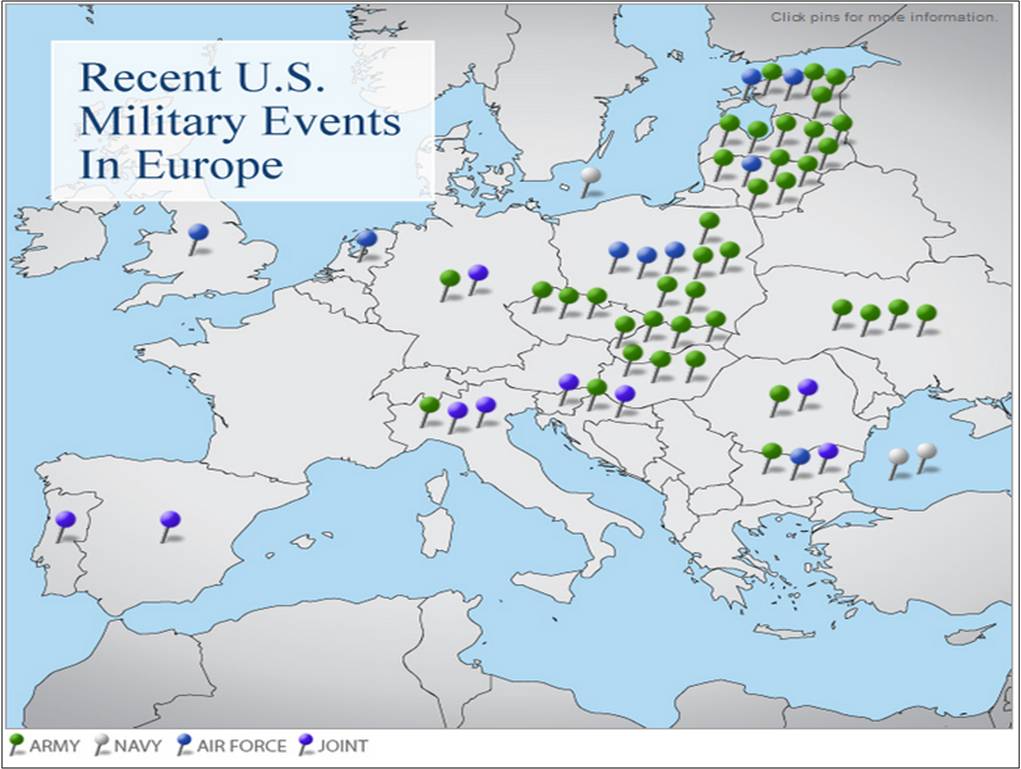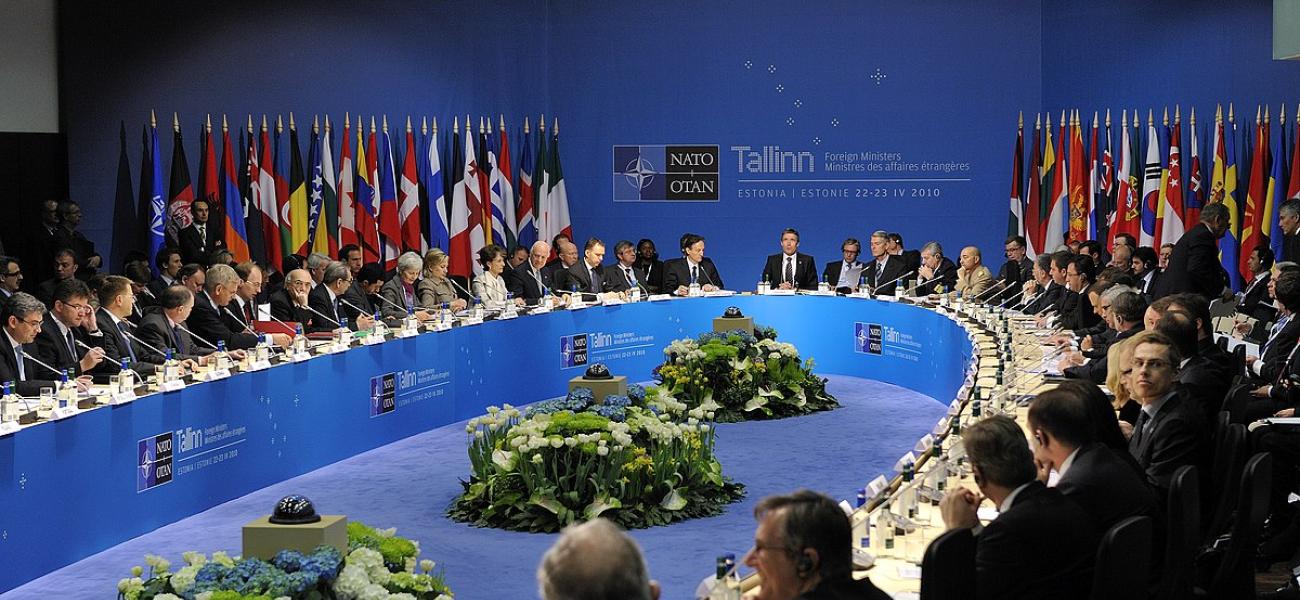
The Democratic Party is supporting
an endless proxy war and has been
reluctant to press Biden to
pursue a negotiated settlement
Joseph Gerson / Common Dreams
(July 12, 2022) — It is no secret that the United States and NATO are engaged in a proxy war with Russia, perhaps to be fought to the last Ukrainian. In June, as heads of state gathered in Madrid for the Alliance’s annual summit, I joined more than 10,000 activists from across Spain and around the world for mega anti-NATO peace conferences and a massive No to NATO rally.
Their focus was not only NATO’s roles in the Ukraine War but also its transformation into the world’s dominant GLOBAL alliance whose new strategic concept also prioritizes containing China. Highlighting this transformation, the Prime Ministers of Australia, Japan, New Zealand, and the Republic of Korea joined the summit for the first time in the Alliance’s history.

LESSONS FROM THE EUROPEAN LEFT
Before turning to NATO’s history and decisions taken at the summit, there were a number of lessons I took from the European Left while in Madrid and elsewhere during my recent travels in Asia and Europe.
- There are divisions in Europe over the Ukraine War that mirror those in the United States, but there is unanimity that NATO’s expansion to Russia’s borders was a provocation that contributed to Vladimir Putin’s decision to launch his invasion. There is also near unanimity that the invasion must be condemned as a gross violation of the U.N. charter and other international laws. European peace movements call for an immediate ceasefire and negotiations leading to guarantees that Ukraine will endure as a sovereign and neutral nation. Some urge that the future status of Crimea and the Donbass remain in limbo, to be resolved in negotiations over the course of years. There are also calls for the Organization for Security and Cooperation in Europe (OSCE, see more below) to convene a summit in 2025 to begin the negotiations for a new security architecture for Europe.
- Contrary to the image of NATO being more unified than ever, there are fault lines. The Baltic and Eastern European nations demand a harder line, including Russia’s defeat in Ukraine, while the core nations of France, Germany and Italy press for a negotiated end to the war. There are also deep concerns that the severe reduction of imported Russian oil and gas will leave people’s homes freezing and factories without power in the coming winter. This, it is expected, will lead to protests and openings for the far right to gain influence and power in Europe.
- Among Germans who value ties built with Russia beginning with Willy Brandt’s Ostpolitik, there is a belief that German economic success was built less by German expertise than by cheap Russian energy which will no longer be available.
- With U.S. gun violence, near-daily mass shootings, and the rash of horrendous Supreme Court decisions, Americans are increasingly seen as barbarians at the gate.
- For Europeans, especially Spaniards, there is horror and outrage at the death toll of immigrants—most recently in Spain’s Melilla enclave—as European and NATO forces enforce bans on desperate non-white immigrants.
- There is a deepening critique of European and NATO military spending, including the addition of 100 billion euros to Germany’s military budget which will make Berlin the world’s third greatest military spender, and which will transform the European military and political landscapes.
- When Donald Trump questioned the future of the NATO alliance, France and Germany placed greater emphasis on building an independent European military. That dynamic is moving forward, now fueled by multiple interests and uncertainties about who will be in the White House following the 2024 presidential election and by fears of Russian imperial ambitions. There is debate over whether this will result in a division of NATO and EU military labor—especially in North Africa and the Middle East—or whether the EU military will emerge as a rival to NATO over the longer term.
- I began my odyssey in Mongolia where a conference led by the country’s former president and national security advisor celebrated and reinforced the country’s 30-year old unique single nation nuclear weapons-free zone. In addition to the Zone’s contribution to creating a nuclear weapons-free world, it was initiated to help guarantee Mongolia’s independence from both China and Russia. I also learned that Mongolia’s first national security priority is keeping China’s investments to less than 30% of the nation’s total, again to preserve Mongolian independence. This was a lesson about China’s Belt and Road Initiative and the enduring tradition of China’s tributary approach to empire.

HISTORY & NATO’s NEW STRATEGIC CONCEPT
In the United States, public perceptions of NATO remain rooted in the Cold War misconception that NATO is an exclusively defensive alliance. In Europe there are recent memories of NATO’s aggressions in Afghanistan, Serbia, Libya, and Iraq. There is also memory of NATO’s first General Secretary’s, Lord Hastings Ismay, who stated that the purpose of NATO was to “keep the Russians out, the Americans in, and the Germans down.”
Hasting’s observation helps us understand why NATO was not retired when the public rationale for its existence, defense of Western Europe from possible Soviet invasion, evaporated with the demise of the Soviet Union in 1991. But Zbigniew Brzezinski, President Carter’s national security advisor. provided a more detailed explanation in his seminally important primer about how to maintain the United States’ “imperial project,” The Grand Chessboard.
Reaffirming the geopolitical theory that whoever controls the core of Eurasia will be the world’s dominant power, and noting that the United States, like Britain before it, is an “island power,” he explained that NATO is critical to U.S. global dominance. It provides the “toehold” on Eurasia’s western periphery, reinforced by its other toeholds in the Middle East and Central Asia, and by its Asia-Pacific allies. Even before Moscow’s invasion of Ukraine, the U.S. had 100,000 troops and hundreds of military bases and installations deployed across a still functionally militarily occupied Europe.

While Russia’s invasion of Ukraine is an unacceptable and deadly violation of the U.N. Charter and other international laws, it also appears to have been driven by two primary forces: Moscow’s perceptions of Russia’s strategic vulnerability given NATO’s expansion to its borders (including deepening integration of Ukraine into NATO’s systems) and by the desire to restore much of the Russian imperium that was lost with the collapse of the Soviet empire.
Few in the United States are aware of Europe’s 1990s Common Security commitments and the vision of a “Common European Home,” which included Russia. In 1990 the OSCE (Organization for Security and Cooperation in Europe), inclusive of both the United States and Russia adopted the Paris Charter.
This commitment was reiterated in the NATO-Russia Founding Act, and again in the 1999 OSCE Charter for European Security. And, despite it never have been committed in writing, in the U.S.-Russian negotiations leading to German reunification on West German terms, the GHW Bush Administration committed not to move NATO a centimeter closer to Russia’s border.
Why was this important to Russia? Just as deep as our national memories of Washington crossing the Delaware, of our deadly Civil War, and of Japan’s attack on Pearl Harbor, are Russian memories of catastrophic invasions from the West, first by Napoleon and later by the German Kaiser and Hitler.
Yet as Russia’s political and economic systems imploded during Boris Yeltsin’s rule, and in the tradition of the arrogance of power, despite George Kennan, the architect of the Cold War containment doctrine’s warning that it would lead to disastrous conflict, in 1999 President Clinton initiated the campaign to enlarge NATO. Poland, Hungary, and the Czech Republic became alliance members.
Bush II added seven Central and Eastern European nations in 2004. In 2007, despite his senior advisor Fiona Hill’s warning that inviting Ukraine and Georgia would lead to war, and against the opposition of Germany and France, Bush the Lesser forced the invitation to Ukraine and Georgia through NATO’s 2007 summit.
In its immediate aftermath, the Georgia-Russian war followed. It has been reported the Putin began his planning for the Ukraine invasion in response to the welcome mat put out by NATO for Kiyv. Baltic and other Eastern and Central European nations were also welcomed to NATO.

Even before Russia’s invasion of Ukraine, U.S. and German military forces were deployed and conducted military exercises along Russia’s borders, and U.S. and Russian warships and warplanes conducted provocative and extremely dangerous military “exercises” in the Baltic and Black Seas.
Yet, even as NATO was expanding eastward toward Russia, it also became a global alliance. Today German, Dutch, English, French, Japanese and even Indian warships join provocative U.S. naval “exercises”in the South China Sea. “Partners”including Columbia, Australia, Iraq, Japan, South Korea, New Zealand, Mongolia and even Pakistan were added to the alliance.
NATO’s webpage tells us that these partners “are part of many of NATO’s core activities, from shaping policy to building defense capacity, developing interoperability and managing crises.” The Alliance also has formal partnership frameworks including the Euro-Atlantic Partnership Council, Partnership for Peace, the Mediterranean Dialogue, and the Istanbul Cooperation Initiative, each of which serve similar purposes to the formal partnerships.

SUMMIT DECISIONS & NATO’S NEW STRATEGIC CONCEPT
As our movements recalibrate in order to address the growing threat to what remains of constitutional democracy, human and political rights and existential nuclear and climate threats, we need to bear in mind NATO’s impacts on the new era of great power confrontation and what Michael Klare terms “blockification.” In addition to NATO becoming global, Russia is increasingly dependent on China, and a new movement of non-aligned nations is trying to be born.
At the Madrid Summit, NATO Leaders took what they described as “transformative decisions” with the “biggest overhaul”of the “allied collective defense” since the Cold War and set the Alliance’s strategic direction for the near and long-term future. Contrary to earlier expectations that the Alliance’s focus on Russia would be downgraded, with China being named as NATO’s #1 priority. But with the Ukraine War NATO’s Strategic Concept named Russia as the “most significant and direct threat.”
It was followed by China being named for the first time as a threat to the rules based order, followed by the challenges of terrorism, cyber and hybrid warfare. (It is important to remember that the post-war Bretton Woods “order” was imposed without meaningful Chinese input when the Middle Kingdom was impoverished and weak. Like any other major power, it seeks to advance what its elite identifies as the country’s national interests.)
Commitments to continuing arming and supporting Ukraine were reiterated at the summit, as well as deepening Ukraine’s integration with the Alliance by supporting its transition from Soviet-era military equipment to modern NATO equipment.
More troops and more pre-positioned equipment and weapon stockpiles will go to Eastern Europe and the Baltics, with NATO’s eight multinational battlegroups growing exponentially from 40,000 to 300,000 troops. NATO was reaffirmed as a nuclear alliance. The alliance doubled down on Ukraine and Georgia, reaffirming the commitment to NATO’s “Open Door” policy for aspiring members.
As part of the “Open Door,” Sweden and Finland were invited to join the alliance, doubling the length of NATO’s border with Russia. Member states committed to spending at least 2 per cent of their national GDPs by 2024 for their militaries. And new support commitments were made for “other partners at risk,” including Bosnia and Herzegovina, Georgia, and the Republic of Moldova.
With no apparent sense of shame or acknowledgment of what George Orwell termed “double speak,” the allies reiterated their “strong commitment to the rules-based international order and Allies’ shared values of individual liberty, human rights, democracy, and the rule of law.”
Missing from photographs of the assembled national leaders must have been the smirks on the faces of Turkey’s, Hungary’s, and Poland’s leaders, not to mention President Biden and Secretary Blinken as they contemplated planned summits in Israel and Saudi Arabia.

BY WAY OF CONCLUSION
There is no denying that we are moving into an increasingly dangerous period. NATO, Russia and Ukraine are committed to fighting a long war which could escalate geographically or to the possible use of weapons of mass destruction. The Democratic Party is unquestioningly supporting an endless proxy war and has been reluctant to press President Biden to prioritize a negotiated settlement to the war.
The illegitimate U.S. Supreme Court majority and those associated with the January 6 insurrection are plotting to secure white supremacist, medieval Christian, and corporate power for the long term.. And the war, the contest for primacy with China, and the recent Supreme Court EPA decision are sentencing future generations to climate catastrophes.
Noam Chomsky reminds us that these crises were created by humans and that we know their solutions: Impose a cease fire and negotiate a just settlement of the war. Abolish nuclear weapons. Invest in clean energy and protect our coastal cities against surging tides instead of funding the Pentagon with more the military spending than the world’s next 10 biggest military spenders COMBINED! Expand and defend an inclusive if imperfect democracy. Restore a progressive graduated income tax to weaken the oligarchs and provide economic security.
Where then are sources of hope and inspiration? There are no easy answers in this dark time. On the one hand, I wish that I could transmit the commitments and surging energy of the thousands who rallied in Madrid.
The Poor People’s Campaign here in the United States provides a model and foundation for intersectional organizing and advocacy. There is inspiration to be taken from the centuries of African-Americans daily struggle for liberation and freedom against oppressive political and social systems stacked against them.
Having had the extraordinary privilege of working with women and men who resisted Nazi rule in Hitler’s Europe, nonviolently and otherwise, I take inspiration from their quiet courage. There is also the reality that within the oppressive rule of Soviet commissars in Eastern Europe and U.S.-backed oligarchs across Latin America people built culture and foundations for greater freedom.
And there is Leonard Cohen’s poetic insight that “There is a crack in everything/that’s how the light gets in.”
Joseph Gerson is President of the Campaign for Peace, Disarmament and Common Security, Co-founder of the Committee for a SANE U.S. China Policy and Vice President of the International Peace Bureau. His books include Empire and the Bomb, and With Hiroshima Eyes.
Our work is licensed under Creative Commons (CC BY-NC-ND 3.0). Feel free to republish and share widely.